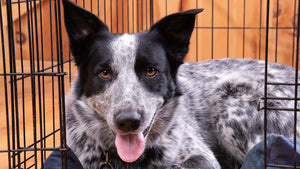Your Cart is Empty
💗FREE shipping on Oprah's Favorite Dog Walking Bag! Everything ships FREE on orders over $30 💗
💗FREE shipping on Oprah's Favorite Dog Walking Bag! Everything ships FREE on orders over $30 💗
💗FREE shipping on Oprah's Favorite Dog Walking Bag! Everything ships FREE on orders over $30 💗
💗FREE shipping on Oprah's Favorite Dog Walking Bag! Everything ships FREE on orders over $30 💗
Add description, images, menus and links to your mega menu
A column with no settings can be used as a spacer
Link to your collections, sales and even external links
Add up to five columns
Add description, images, menus and links to your mega menu
A column with no settings can be used as a spacer
Link to your collections, sales and even external links
Add up to five columns
October 15, 2021 10 min read
It’s a collective experience among dog parents: you go to give your dog a kiss or play with them, and you’re hit with a whiff of awful dog breath. We love our dogs, but bad breath can make it a lot harder to show the love! Plaque, tartar, and bad breath are three very common issues affecting dog dental health. While brushing your dog's teeth daily as vets recommend averts most of these dental problems, some critical areas in your dog's mouth are hard to reach. Plaque and tartar like to hide in these tricky spots. That's where dog dental chews, treats, and sticks come in to save the day.
Proper dog dental health is necessary to keep your pup happy and healthy. It’ll keep you happy, too, as you’ll avoid that bad breath that is all too common. But keeping up with daily brushing and flossing isn’t always easy, especially when life gets busy. Fortunately, canine dental chews, sticks, and treats are great solutions that naturally eliminate plaque, tartar, and bad breath in dogs.
Let's face it, chewing is a favorite hobby for many dogs. Dog dental chews take advantage of this canine habit by scraping your pup’s teeth while they chew, helping to get rid of plaque. Most vets will tell you that dogs with a healthy chewing habit are at a lower risk of developing plaque and tartar.
There are several other benefits of incorporating dental treats into your dog’s oral care routine:
Although brushing your dog's teeth daily helps fight bad breath, plaque, and tartar, it is not always enough to fully keep these problems at bay. Supplementing with dental chews helps avoid plaque and tartar buildup in those hard-to-reach areas, lowering the risk of canine halitosis (bad breath).
Dog dental chews and treats provide a portable, all-day solution for maintaining canine oral hygiene. They come in handy when you have little time to spare and want to make sure you’re keeping your pup's teeth clean and healthy. Use dental chews when you have a busy schedule or are out traveling with your dog. Because chewing is a favorite pastime for most pups, a dental chew or stick will keep them busy while you go about your errands.
There is no one-product-fits-all when it comes to buying dental chews or treats. Consulting your vet before offering your dog any of these alternative breath-freshening products is always a good idea. Reading up on reviews and ingredients can also help ensure that the products you’re giving your dog are safe and effective. There are a few more things to consider before you purchase dental chews, sticks, or treats for your pup.
Longevity
How long does the effect of the chew last? You can certainly expect the chew to reduce plaque and help bad breath, but the effects may only be short-term. Investing in durable, non-edible dog dental chews or sticks provides a long-lasting solution. Since these dental sticks and chews cannot be eaten, your pup will be gnawing on them longer, extending the benefits of the chew. Be sure to inspect them regularly and replace them when they eventually do start to fall apart.
Ingredients
Only buy dental sticks, chews, or treats whose ingredients are safe and approved by the Veterinary Oral Health Council (VOHC). Always read the label to ascertain that the ingredients used are safe and healthy for your dog. You may want to avoid grain-based dental chews and sticks if your dog has grain allergies or needs to lose weight.
Proteins and fats
The protein-to-fat ratio is important when it comes to dental treats: consider buying dog dental treats that have more proteins than fats. High-quality dental chews or sticks will have about 80% protein and 2% fat. Vet-approved dog chews and treats contain special chemicals that coat the teeth to prevent bacteria buildup.
Baking soda
Baking soda or sodium bicarbonate is a brilliant and all-natural ingredient for scraping off tartar build up. Dental chews or treats infused with baking soda can also get rid of pesky oral bacteria that cause infections and diseases like periodontal disease. Make sure there are only small amounts of baking soda in any homemade dog dental treats. In high amounts, sodium bicarbonate can alter the acid balance in your dog’s tummy.
Parsley
Parsley, in healthy doses, is a superfood in your dog’s diet. Besides being a source of Vitamin K, parsley acts as a natural breath freshener when used in dog dental chews and treats. Also, a pinch of parsley has antioxidants that fight free radicals in the body. This amazing herb also has great anti-inflammatory properties. A teaspoon of parsley per 20 lbs. of body weight will be enough to supply your pup with all of these benefits. Do not confuse fresh, curly-leaf parsley with spring parsley, an herb in the carrot family considered toxic to dogs.
Coconut oil
Coconut oil is a natural oil that is safe for dogs in limited doses. Used in dog dental treats, coconut oil helps with removing tartar and freshening the breath. Coconut oil is also good for your dog’s skin and coat, so it is a multi-purpose ingredient for dog owners!
Apples and carrots
Apples and carrots are good for your dog whether eaten raw or used for dental hygiene. Carrots or apples prevent plaque formation as your dog chews on a slice. These two fruits also act as breath fresheners when used in dental treats.
Apple cider vinegar
Apple cider vinegar is a natural breath freshener for dogs. This natural acid also detoxes the kidneys and reduces symptoms of gastrointestinal infection. However, it should always be diluted and the amount that you allow your dog to ingest should be limited, as it is quite acidic.
Wheat, corn, soy
Wheat, corn, or soy-based dental treats have high calorie counts that may not necessarily benefit your dog. In fact, some pets find it hard to digest these grains in their diet. Wheat, corn, and soy are only used as fillers in dental treats and often do not have any added value nutrient-wise.
Meat by-products
Meat by-products are left over products from slaughtered animals. They are low-quality protein sources that have little to no nutritional value when used in dental treats.
Preservatives
Pet parents are now looking for healthy alternatives for their furry friends that do not contain synthetic preservatives. When buying dental treats for your dog, avoid products that contain ethoxyquin, Propyl Gallate, BHT, and BHA. These are preservatives banned in human foods because they are linked to cancer. Only go for dog dental treats made with organic preservatives like rosemary, citric acid, vitamin E (tocopherol), and ascorbic acid.
Size
Size does matter when buying dog dental treats. Make sure to buy chews or treats that are appropriate for your pup’s size. You may have to measure your dog’s oral cavity or have a vet do it for you. Oftentimes, brands will specify which size pup their treats are designed for.
Taste
It may not seem like it when they’re out for a walk trying to eat everything they see, but dogs are picky (to some extent) when it comes to what they munch on. Most chews and treats come in dog-enticing flavors like beef or chicken. Find out what sits well with your pup, but remember to ensure that the flavors used in the product are from real proteins and not synthetic enhancers.
Texture
Soft, hard, or in between? Soft-textured chews are ideal for small dog breeds or fragile teeth while the tougher chews suit incessant chewers. Some dental treats and chews have an ergonomic design meant to reach into inaccessible areas and get rid of plaque as your dog gnaws away.
A lot of pet companies market these products interchangeably. However, there are notable differences in the composition and functionality of these three products. Read on to learn which is best for your dog!
Dental Treats for Dogs
Dental treats are the staple of most homes when it comes to edible dental care for dogs. They are inexpensive, easily accessible, and pack different flavors that dogs of all sizes and ages love. There are all sorts of varieties of dental treats, so as a pet parent, you have to choose what works for your pet.
Dental treats are most often edible. The edible versions consist of dental chew bones and biscuits that serve as tasty treats too. Since they are gobble-worthy, your pooch will probably be more than willing to eat them. As long as the tasty treat is not high in calories or fats, and they are eating a moderate amount, then you do not have to worry about your dog putting on excess weight.
To be safe, you can set up a routine for feeding treats to your dog. The best time to give treats is in between meals or during obedience training. The treat serves as a reward and an effective way to clean your dog's teeth and reduce bad dog breath.
The only downside of edible dog dental treats is that their effects are not long-lasting. These treats take less time to chew and do not stay in the dog's mouth very long, so their effects are short-term.
How often should you serve dog dental treats?
You should only serve your dog a limited amount of treats in a day. Also, the smaller your dog, the fewer dental treats they should consume. Be sure to read the recommended frequency on the product label for healthiest results.
Dental Chews
Unlike dental treats, dental chews are not edible, giving them a long-lasting effect on your dog's mouth. Dental chews are ideal for fighting persistent dog bad breath because of their more enduring properties.
Dental chews can either be in the form of animal-sourced products or toys. The animal-sourced versions feature high-quality products such as elk or deer antlers
Toy-based dental chews are made with a unique texture. The chew has a bendable texture to scrub off plaque in hidden areas of your dog's teeth. Some doggy chews have a two-sided design to reach both the upper and lower gums of your dog’s mouth. As your pup happily gnaws on the chew toy, it creates abrasion to help remove tartar and plaque.
Dog oral chews can have special chemicals in them to fight plaque and tartar. One such chemical is chlorhexidine, which acts as a safe and effective mouthwash for dogs. Traces of chlorhexidine will remain in your dog's mouth to kill bacteria long after your pup stops chewing on the toy.
Another chemical used in dog dental chews is delmopinol. Delmopinol coats the tooth enamel, stopping tartar build-up. In addition, this chemical has antimicrobial qualities to wipe out tartar in seconds. As you shop around for chews, you will also come across products that are enzyme-activated to fight bacteria, plaque, and tartar.
How often should you give a dog dental chews?
Remember that chews are only ideal for fighting the initial stages of dog bad breath. If bad breath persists even after you’ve taken steps to increase dental hygiene, there could be an underlying medical concern that needs a professional diagnosis from a trained vet.
Dental Sticks for Dogs
Dental sticks generally have a longer chew time compared to treats but will not last as long as inedible chews. They also come in various sizes that suit different dog breeds. Like chews and treats, dental sticks are very handy for temporary teeth cleaning and preventing bad breath, bacteria, and tartar.
Chewing on a dental stick increases saliva production. Active ingredients in the product dissolve in saliva to clean bacteria and plaque from your dog's mouth. Dental sticks also have a tough texture that increases chewing time (and makes your pup happy!)
Most dental sticks are plant-based and grain-free. They are low in calories and perfect for a pup that is watching its weight. Dental sticks come in amazing (for your pup) flavors like beef, chicken, peanut butter, and lamb. Some dental sticks have parsley and fruit flavors like crisp apple and strawberry to counteract stinky breath.
Ensure you check the size when buying dog dental sticks. Ideally, small-sized sticks suit toy breed dogs that weigh less than 20 pounds. The mid-sized dental sticks suit dogs that weigh between 20 and 50-pounds. Larger dental sticks are for dogs weighing 55 pounds and above.
The type of dental stick you buy also depends on your dog's chewing habits. If your dog chews an entire stick in minutes, a larger one may be more appropriate. Also, the texture of the stick will determine how long it takes for your pup to finish it.
Pup tip: you can air-dry dental sticks to make them harder and increase their chew-time.
When introducing dental sticks to your dog, make sure to monitor their chewing habits. If you notice your pup gagging or struggling to gnaw, try a smaller size. Do not give dental sticks to puppies that are still developing their teeth. Dog dental sticks may not be ideal for senior dogs with pre-existing teeth and oral problems like advanced gum disease, loose, chipped, broken, or missing teeth.
Remember to keep an eye on your dog as they are chewing to prevent choking!
How often should you give your dog dental sticks?
In most cases, one stick a day is enough to kill bacteria and improve bad breath. Let your dog gnaw on the stick after breakfast or dinner. Do not give more than one stick, especially if your dog is on a stringent diet.
Regular teeth cleaning is an important part of your pup’s daily grooming routine and promotes overall well-being and good health. However, it can be hard to keep up with your dog's dental routine and teeth brushing if you are running on a tight schedule or life just gets in the way. Fortunately, it is still possible to clean your dog's teeth and maintain fresh breath with dog dental chews, treats, and sticks.
Always take care to choose the right dental chew, treat, or stick for your dog. Dental treats are mostly delicious edible chews that your dog can enjoy while you keep their teeth clean. But if you want lasting oral care effects, you may have to go for longer lasting dental sticks and chews. Always read the product label to confirm that the ingredients used are VOHC-approved and suit your dog's needs. Using the right dental chews, treats, or sticks will help keep bad breath at bay, and can lead to a healthier, happier pup and a happier pup parent!



Comments will be approved before showing up.